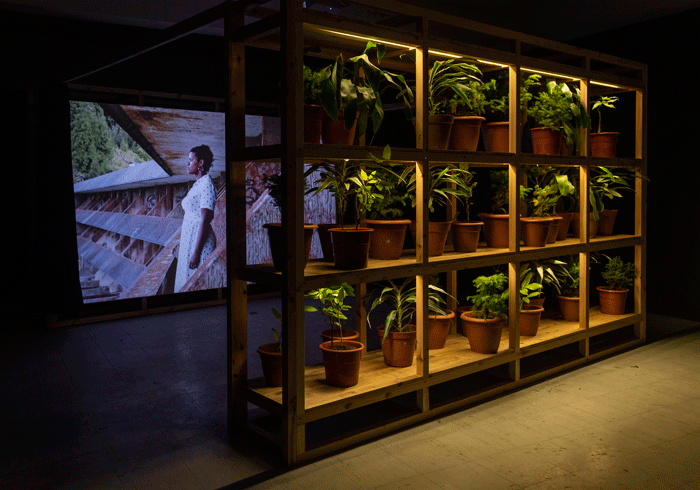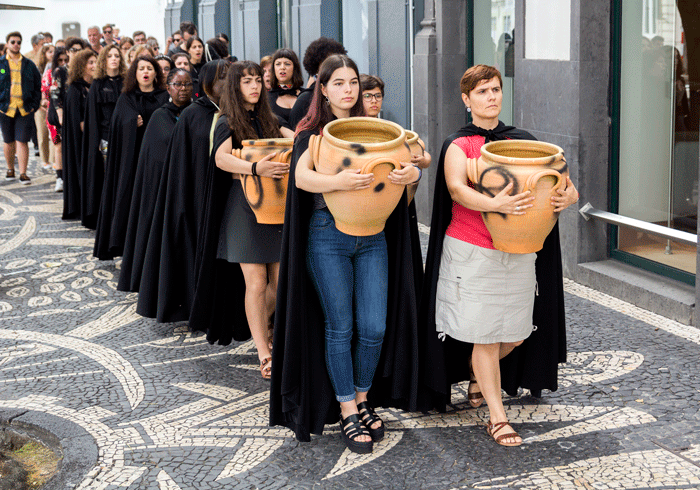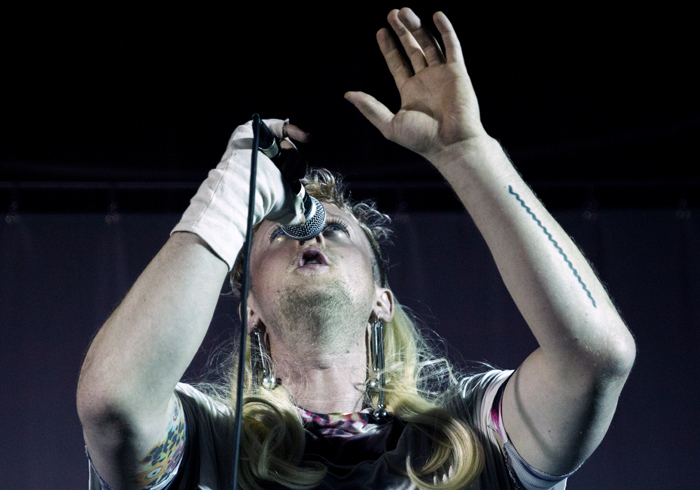Mr Viera is not worried about the new, more modern, tuna factory that has arrived on São Miguel. Sociedade Corretora, of which he is the manager, has been canning tuna since the Second World War. The company itself, originally founded to export pineapples from the Azores to mainland Europe, is even older. The fish come in from the Atlantic, line caught, and are packed half a dozen to a basket, stacked up in a large cage. Each basket is loaded onto a conveyor belt, and taken by one of a dozen or more women – and they are all women, “our husbands catch the fish” one of them tells me – on the production line. Scaled, chopped and packed into open metal tubs (which are industrially stapled together elsewhere in the dockside complex) the tuna pass under jets of golden olive oil. The cans will then be sealed and wrapped either in Corretora’s own branding – an elephant rearing up against a sunny dawn – or that of supermarkets across Europe.
The tuna factory is the second stop of a tour, led by academic Pedro Pascoal de Melo, that has already taken in a former nunnery on the Azorean island. Afterwards we will visit the islet of Vila Franca do Campo, one kilometre off the coast, and learn how the crescent-shaped landmass, now a nature reserve and bathing destination, is the crater of an ancient submerged volcano. The day finishes with an architectural tour of a private house designed by Pedro Mauricio Borges. Accompanying me on this eclectic schedule, the day conceived by Porto-based architects and producers Talkie Walkie (the coincidence of the names inspired the collaboration) are a couple of artists showing at the Walk & Talk festival, as well as a handful of punters who have paid €15. During my stay in the Azores more tours and activities (the majority free) are devised by the festival, most of them ostensibly nothing to do with the art, but all attended by the artists exhibiting, and most importantly, those showing next year. Hot springs are visited, tea plantations explored (the Azores has the perfect climate for tea production and produces an excellent green leaf). I was there just a couple of days but undertaking two-week residencies are artists including Montreal-based Abbas Akhavan, newly baptised Londoner Alice dos Reis and Pittsburgh’s Danny Bracken. The public, to all intents, are piggy-backing on their site visits: whether any of them will choose to make work about tuna for the 2020 festival, or the subjects that such a factory might propose – systems theory, gendered labour, island economics, oceanography, collapsing fish stocks – remains to be seen.
What work that is on show during the opening weekend of this year’s festival did not, however, always live up to the richness of the source material. The Azores is a complex place, for all its sunny veneer, and complex subjects require complex artworks. One of the festival’s organisers notes that after numerous previous residents (the festival is in its tenth year) attempted artworks featuring the community of Rabo de Peixe, a deprived area in which drug use and prostitution are issues, they stopped taking artists there. Instead, the festival runs longer-term outreach projects. East Atlantic (all works 2019) by Miguel C. Tavares and José Alberto Gomes, a multimedia work performed at the Arquipélago arts centre and comprising a 50-minute film and live soundtrack, instead looks to trade and ‘exploration’ routes past and present, in a cinematic recording of the journey a cargo ship makes from mainland Portugal to the islands. The film, while seductive, stylistically owes much to figures such as John Akomfrah, Adrian Paci or Yuri Ancarani in its lack of dialogue, high gloss and rich, booming audio. Mónica de Miranda’s In(sul)ar, is shown on the empty top floor of a shopping centre, in a viewing room decked out with plants. In the work the Lisbon-based artist, whose previous work I am a fan of, can be seen wandering, and singing, in the Monte Palace, an abandoned hotel on the island. Ideas of Europe in decline abound, but this particular location has featured in so many artworks and fashion shoots previously, the resonance falls flat.


The performance programme was much better: Luanda-based Rita GT orchestrated a parade that stretched from the town hall of Ponta Delgada to the Museu Carlos Machado, a curious institution set in a former convent, and in which a collection of taxidermy is preserved. Involving local choral singers who, all female and dressed in black capes, chanted as they walked the town’s narrow streets. “Some sort of local religious thing?” ventured one middle-aged American tourist enjoying an early evening drink in a local cafe. He was correct to a degree. Each of the singers held a large earthenware pot, traditionally used in cooking on the island. This subversion of the usual male-led ceremony, invoking female labour, reached its zenith in the former chapel of the museum. Here, the pots were laid in a row, their forms recalling the female body, a retort to the male saints that gazed down from statues and icons that decorated the cavernous building. That night, in another play on sex, Colin Self performed a riotous set in the square outside the island’s theatre. In a white rags, long earrings and a touch of makeup, and to a hard techno tape, the American musician roared, squawked, chattered and, occasionally, in case we got used to this aural anarchy, sang falsetto to magnificent effect. With such ferocious energy, as much collapsing the demarcations of gender, as a performer, Self also blurs the lines of human and animal.

Yet the actual materialised artworks appear intentionally incidental to the Walk & Talk ethos. The square Self performed in also hosted a nightly meal, followed by music, which anyone was free to join. Each of the tours, visits, swims and picnics were also designed to facilitate conversation and collapse boundaries between artists and audience. This was less an art show, more a project in social engineering. And much more rewarding for it than plodding through yet another biennial. Walking a circuit of Lake Furnas on the west of the island a few of us talked about the myth of Azoreans being the descendents of exiled Jews, and the Jewish people of Portugal being forced out under the country’s Inquisition in 1536; during a visit to some local artists’ studios someone mentions the eccentric figure of João Pacheco de Melo, a lone activist still agitating for Azorean independence, whose face can be found stencilled on walls throughout the Azorean capital; climbing the steps of a bell tower in São Roque, conversation turns to the devastating earthquake of 1522. Perhaps this is the natural conclusion to art’s dematerialisation. The artworks felt a little flat – and in the end, it didn’t matter – because the stories that provided their source material, received first hand and without mediation, were so rich. Of course, art should be more than a good yarn – a point, talking more generally, Akhavan made outside a bar in the old town one evening. There should be a transformative aspect that justifies the form, a conceptual point spun from the history. Yet here, gathering together anyone who wanted to take part, walking and talking proved a radical alternative to seeing.
Online exclusive, 12 July 2019
